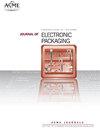Interaction of Surface Preparation and Cure Parameters on the Interface Reliability of Flexible Encapsulation in Flexible Hybrid Electronics Applications
IF 2.3
4区 工程技术
Q3 ENGINEERING, ELECTRICAL & ELECTRONIC
引用次数: 0
Abstract
Abstract Flexible devices, which are seen as the future of the electronics industry, require encapsulation for protection while meeting the flexibility requirements of end applications. Flexible electronics have lower production costs and are thinner, lighter, and nonbreakable, resulting in a new form of application for electronic devices. One such use is the employment of electronic gadgets in the daily surroundings to monitor one's vitals. These devices are frequently exposed to dust, perspiration, and moisture. They are frequently subjected to bending and folding action, which causes stresses to accumulate in those devices. These stressors and the hostile environment are frequently minimized by using potting encapsulants to increase durability. In our investigation, we picked six distinct encapsulant formulations and exposed them to varied cure profiles to measure the adhesive bond strength of the encapsulants. The benchmark peel strength was constructed using a Finite element model of the AU-biometric band. The encapsulants peel strength was used to determine which material performed best under experimental conditions. This study presents a sample geometry comprising six different encapsulants and two distinct substrates, polyimide and PET, which were evaluated at four different cure schedules and cleaned using two different cleaning procedures. The encapsulants are ranked against one another to determine their potential future usage in flexible hybrid electronics (FHE) devices.柔性混合电子应用中,表面制备和固化参数对柔性封装接口可靠性的影响
柔性器件被视为电子工业的未来,需要封装保护,同时满足终端应用的灵活性要求。柔性电子产品的生产成本较低,而且更薄、更轻、不易破碎,为电子设备带来了一种新的应用形式。其中一个用途是在日常环境中使用电子设备来监测自己的生命体征。这些设备经常暴露在灰尘、汗水和湿气中。它们经常受到弯曲和折叠的作用,这导致应力在这些设备中积累。这些压力源和恶劣环境通常通过使用灌封剂来减少,以增加耐用性。在我们的研究中,我们选择了六种不同的封装剂配方,并将它们暴露在不同的固化曲线中,以测量封装剂的粘合强度。使用au生物识别带的有限元模型构建基准剥离强度。在实验条件下,用包封剂的剥离强度来确定哪种材料表现最好。本研究展示了一个由六种不同的密封剂和两种不同的基材(聚酰亚胺和PET)组成的样品几何形状,在四种不同的固化计划下进行了评估,并使用两种不同的清洁程序进行了清洁。这些密封剂被相互排列,以确定它们在柔性混合电子(FHE)设备中的潜在未来用途。
本文章由计算机程序翻译,如有差异,请以英文原文为准。
求助全文
约1分钟内获得全文
求助全文
来源期刊

Journal of Electronic Packaging
工程技术-工程:电子与电气
CiteScore
4.90
自引率
6.20%
发文量
44
审稿时长
3 months
期刊介绍:
The Journal of Electronic Packaging publishes papers that use experimental and theoretical (analytical and computer-aided) methods, approaches, and techniques to address and solve various mechanical, materials, and reliability problems encountered in the analysis, design, manufacturing, testing, and operation of electronic and photonics components, devices, and systems.
Scope: Microsystems packaging; Systems integration; Flexible electronics; Materials with nano structures and in general small scale systems.
 求助内容:
求助内容: 应助结果提醒方式:
应助结果提醒方式:


